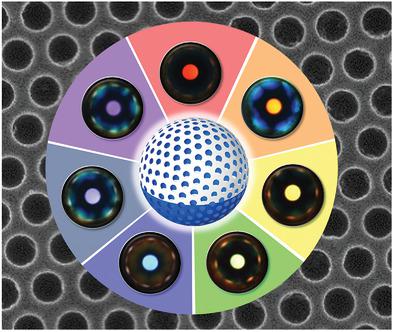当前位置:
X-MOL 学术
›
Adv. Mater.
›
论文详情
Our official English website, www.x-mol.net, welcomes your feedback! (Note: you will need to create a separate account there.)
Plasmonic Janus Microspheres Created from Pickering Emulsion Drops.
Advanced Materials ( IF 29.4 ) Pub Date : 2020-05-14 , DOI: 10.1002/adma.202001384 Jong Bin Kim 1 , Su Yeon Lee 2 , Nam Gi Min 1 , Seung Yeol Lee 1 , Shin-Hyun Kim 1
Advanced Materials ( IF 29.4 ) Pub Date : 2020-05-14 , DOI: 10.1002/adma.202001384 Jong Bin Kim 1 , Su Yeon Lee 2 , Nam Gi Min 1 , Seung Yeol Lee 1 , Shin-Hyun Kim 1
Affiliation

|
Metal nanostructures have been created in a film format to develop unique plasmonic properties. Here, well‐defined metal nanostructures are designed on the surface of microspheres to provide plasmonic microgranules. As conventional techniques are inadequate for nanofabrication on spherical surfaces, photocurable emulsion drops with a regular array of silica particles are employed at the interface to create periodic nanostructures. The silica particles, originating from the dispersed phase, fully cover the interface by forming a non‐close‐packed hexagonal array after drop generation, and slowly protrude to the continuous phase during aging while their interparticle separation decreases. Therefore, hexagonal arrays of spherical dimples with controlled geometry and separation are created on the surface of microspheres by photocuring the drops and removing the particles. Directional deposition of either aluminum or gold results in a continuous film with a hexagonal array of holes on the outermost surface and isolated curved disks in dimples, which renders the hemisphere of microspheres plasmonically colored. The resonant wavelength is controlled by adjusting the aging time, metal thickness, and size of silica particles, providing various plasmonic colors. This granular format of the plasmonic Janus microspheres will open a new avenue of optical applications including active color pixels, optical barcodes, and microsensors.
中文翻译:

从Pickering乳液滴中产生的等离子Janus微球。
金属纳米结构已经以薄膜形式产生,以发展出独特的等离子体性能。在这里,在微球表面设计了定义明确的金属纳米结构,以提供等离子体微粒。由于常规技术不足以在球形表面上进行纳米加工,因此在界面处采用了具有规则排列的二氧化硅颗粒阵列的可光固化乳剂滴,以产生周期性的纳米结构。源自分散相的二氧化硅颗粒在液滴产生后形成非密排六边形阵列,从而完全覆盖界面,并在老化过程中缓慢突出至连续相,同时减小了颗粒间的分离。因此,通过光固化液滴并去除颗粒,可在微球表面创建具有可控几何形状和分离度的球形凹痕六边形阵列。铝或金的定向沉积会导致连续膜,该膜在最外表面上具有六边形的孔阵列,并且在凹坑中具有隔离的弯曲圆盘,从而使微球的半球体呈等离子着色。通过调节老化时间,金属厚度和二氧化硅颗粒的大小来控制共振波长,从而提供各种等离子体颜色。等离子Janus微球的这种颗粒形式将为光学应用打开新的途径,包括有源彩色像素,光学条形码和微传感器。铝或金的定向沉积会导致连续膜,该膜在最外表面上具有六边形的孔阵列,并且在凹坑中具有隔离的弯曲圆盘,从而使微球的半球体呈等离子着色。通过调节老化时间,金属厚度和二氧化硅颗粒的大小来控制共振波长,从而提供各种等离激元颜色。等离子Janus微球的这种颗粒形式将为光学应用打开新的途径,包括有源彩色像素,光学条形码和微传感器。铝或金的定向沉积会导致连续膜,该膜在最外表面上具有六边形的孔阵列,并且在凹坑中具有隔离的弯曲圆盘,从而使微球的半球体呈等离子着色。通过调节老化时间,金属厚度和二氧化硅颗粒的大小来控制共振波长,从而提供各种等离激元颜色。等离子Janus微球的这种颗粒形式将为光学应用打开新的途径,包括有源彩色像素,光学条形码和微传感器。
更新日期:2020-07-01
中文翻译:

从Pickering乳液滴中产生的等离子Janus微球。
金属纳米结构已经以薄膜形式产生,以发展出独特的等离子体性能。在这里,在微球表面设计了定义明确的金属纳米结构,以提供等离子体微粒。由于常规技术不足以在球形表面上进行纳米加工,因此在界面处采用了具有规则排列的二氧化硅颗粒阵列的可光固化乳剂滴,以产生周期性的纳米结构。源自分散相的二氧化硅颗粒在液滴产生后形成非密排六边形阵列,从而完全覆盖界面,并在老化过程中缓慢突出至连续相,同时减小了颗粒间的分离。因此,通过光固化液滴并去除颗粒,可在微球表面创建具有可控几何形状和分离度的球形凹痕六边形阵列。铝或金的定向沉积会导致连续膜,该膜在最外表面上具有六边形的孔阵列,并且在凹坑中具有隔离的弯曲圆盘,从而使微球的半球体呈等离子着色。通过调节老化时间,金属厚度和二氧化硅颗粒的大小来控制共振波长,从而提供各种等离子体颜色。等离子Janus微球的这种颗粒形式将为光学应用打开新的途径,包括有源彩色像素,光学条形码和微传感器。铝或金的定向沉积会导致连续膜,该膜在最外表面上具有六边形的孔阵列,并且在凹坑中具有隔离的弯曲圆盘,从而使微球的半球体呈等离子着色。通过调节老化时间,金属厚度和二氧化硅颗粒的大小来控制共振波长,从而提供各种等离激元颜色。等离子Janus微球的这种颗粒形式将为光学应用打开新的途径,包括有源彩色像素,光学条形码和微传感器。铝或金的定向沉积会导致连续膜,该膜在最外表面上具有六边形的孔阵列,并且在凹坑中具有隔离的弯曲圆盘,从而使微球的半球体呈等离子着色。通过调节老化时间,金属厚度和二氧化硅颗粒的大小来控制共振波长,从而提供各种等离激元颜色。等离子Janus微球的这种颗粒形式将为光学应用打开新的途径,包括有源彩色像素,光学条形码和微传感器。



























 京公网安备 11010802027423号
京公网安备 11010802027423号